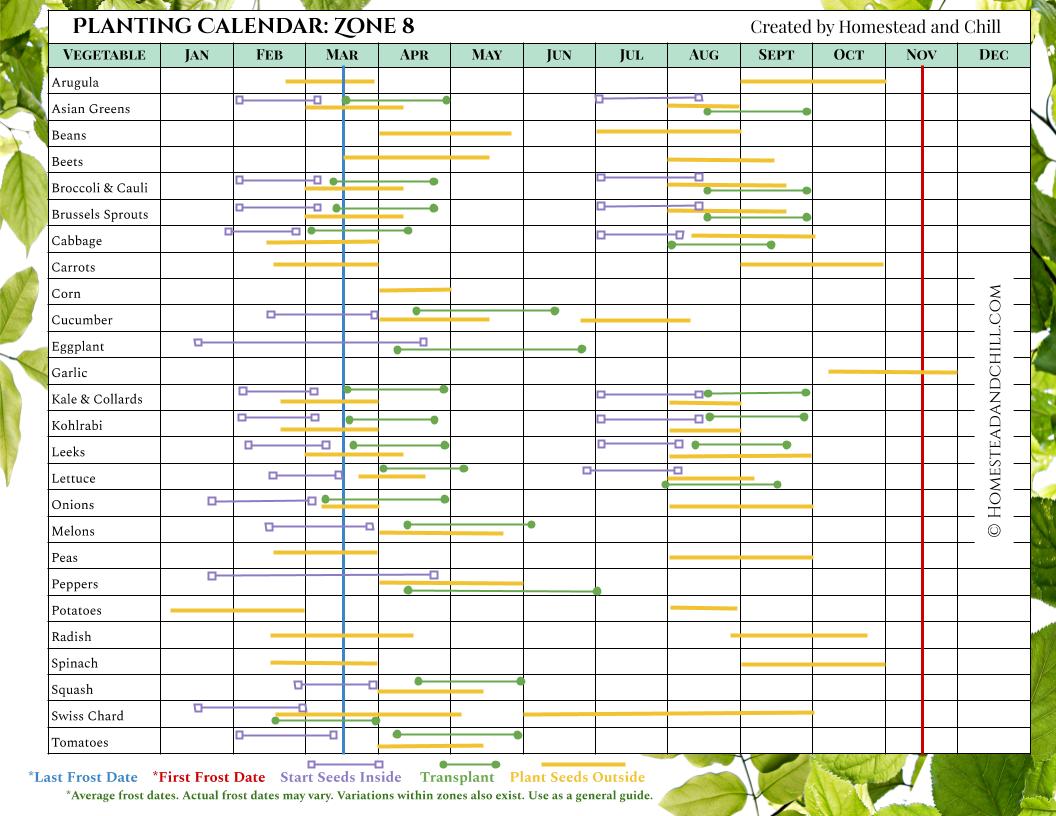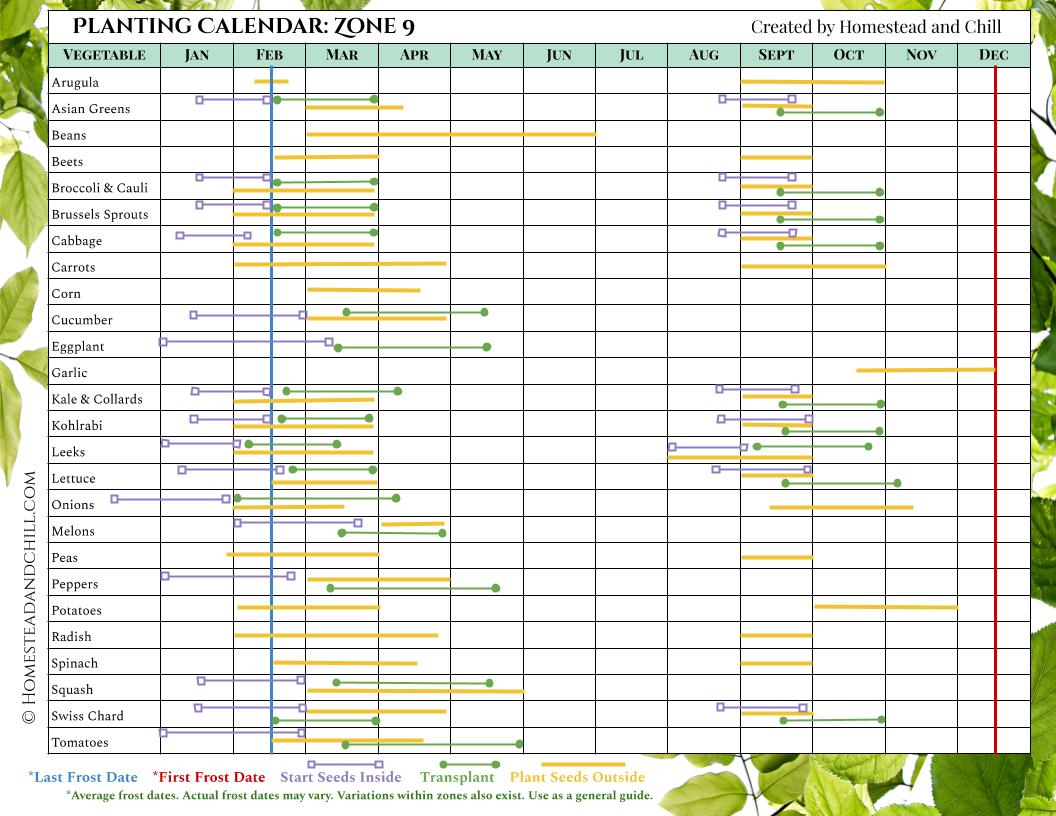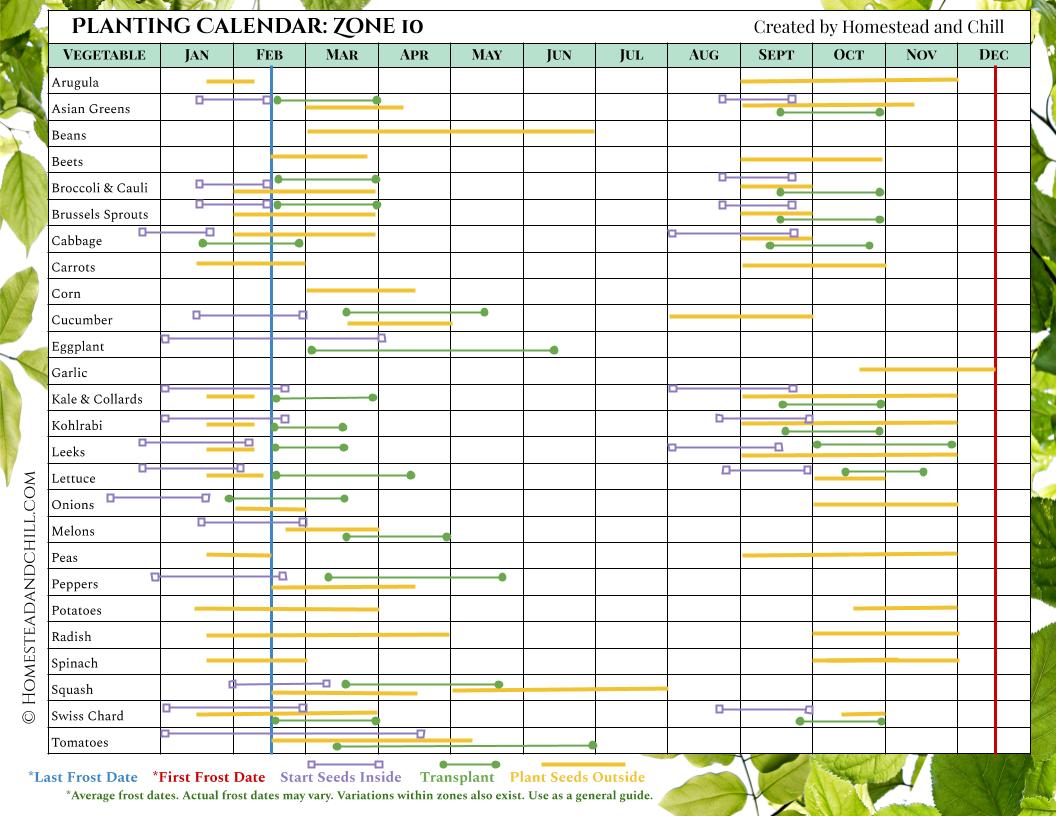By Homestead and Chill | January 7, 2021
Move over ‘farm to table’, and make room for seed to table! Growing a vegetable garden from seed is an incredibly exciting and rewarding process. It doesn’t get any more fresh and nutritious. Yet new gardeners may feel overwhelmed or confused about exactly when to start seeds, and this is an important piece of the puzzle to figure out. Knowing the correct timing when to start seeds and transplant seedlings outside in your particular area is paramount for success! Thankfully, it is fairly easy to get an ideal planting schedule down – once you learn more about your growing zone, frost dates, and the crops you’d like to grow. Even better, we’ve done most of that hard work for you!
- In this article, you’ll find our Homestead and Chill garden planting calendars for every USDA hardiness zone 2 through 12. The planting calendars provide a visual guide on exactly when to start seeds indoors, transplant seedlings outdoors, or sow seeds directly outside – for over a dozen different vegetables! The garden planting calendars are also printable. We keep ours in a sheet protector on our fridge for easy reference.
Not growing entirely from seed? No problem! You can still use the garden planting calendar to determine the best time to plant out nursery bought seedlings in your area too. Just follow the “transplant outside” dates. But first, let’s go over a few concepts that will help you decipher how to make best use of your new garden planting calendar.
Starting Seeds Too Early, or Planting Too Late
What happens when I start seeds at the wrong time, you ask? Well, planting seeds directly outdoors too early in spring can result in slow, uneven, or poor germination results due to cold soil temperatures. Similarly, transplanting seedlings outside too early may put them at risk of harm from frost or inclimate weather. Even in frost-free climates, winter-sown seeds (or transplanted seedlings) will grow very slowly outside due to the short daylight hours compared to when they’re planted in spring or fall.
If you’re an eager beaver and start seeds indoors too soon, you may end up with leggy, overgrown, root-bound, or otherwise overly mature seedlings before conditions are ideal to transplant them outside. Root-bound seedlings may become stunted permanently. Be sure to pot up large seedlings as needed to help prevent this!
On the other hand, starting seeds or planting seedlings too late into the spring season can put your garden behind schedule, and result in delayed maturity and harvests. While they may not like freezing conditions, some vegetable crops thrive in the cooler weather of early spring and will be unhappy if you plop them outdoors in the middle of summer heat. Even worse, a late start in a zone with a short growing season may result in the plant failing to produce it’s bounty before the first fall frost arrives!
Be sure to visit our Indoor Seed Startin Guide to learn all the best practices for seed starting, including how to provide the ideal warmth, light, water, fertilizer, and more. You can also find our favorite seed starting supplies here.

A nice healthy root system on this seedling, starting to wind around a bit… but not yet “root bound”. We prevent our greenhouse (“indoor”) seedlings from becoming root bound by starting them in larger seedling pots and/or potting them up once or twice before they are transplanted outside.
Frost Dates and Seed Starting
Determining the right time when to start seeds indoors (and transplant seedlings outside) begins with learning the frost dates in your area. The “first frost” is the average time of year that the first frost occurs in fall or winter, and it is expected to be increasingly cold from there on out. The “last frost” date is the average time when you may expect the last frost in spring (or late winter) in your area before things begin to warm up once again.
Every type of vegetable has a general recommended timing of when to start seeds indoors or transplant seedlings outside relative to the last spring frost date. Or in some cases, prior to the first frost of fall. For example, if you flip over a package of seeds you’ll likely see instructions such as “sow seeds indoors 5 weeks before last frost” or “plant outside 2 weeks after last the frost has passed”.
As you can imagine, counting forward or backward several weeks to determine the perfect timing to plant dozens of veggies can easily get confusing and difficult to keep track of! Even more, some seed packages don’t include instructions for timing at all. That is where our garden planting calendars save the day, packing all that information into one easy-to-follow page.

Botainical Interests is great about including information on when to start seeds on their seed packages. Not all companies do, which leaves you guessing or looking elsewhere. Curious where we buy seeds? Check out these 12 places that sell organic, heirloom, and non-GMO garden seeds.
USDA Hardiness Zones
The USDA hardiness zone system is largely based around common low temperatures, grouping zones by average frost dates for a certain region. If you aren’t sure what zone you are in, use this handy zip code lookup tool. Once you know your hardiness zone, use the corresponding planting calendar as a general guide. Keep in mind the frost dates are simply averages! Frost dates can vary from year to year, neighborhood to neighborhood, and even amongst microclimates in a single yard. You may need to make slight adjustments for your unique garden.
Also, keep in mind that the hardiness zones do not account for heat, humidity, precipitation, or other climatic factors. For example, our homestead here on the Central Coast of California is located on the border of zones 9b and 10a – the same zones found in the Florida panhandle. However, the differences between those two climates are quite significant! There, they have high humidity, hot summers, and a ton of rainfall. Here, we have cool foggy summers, temperatures are rarely over 80℉, and very little rain. But wait, they’re the same zone?! It’s no wonder some new gardeners feel confused.
It may take a few seasons of trial and error to figure out the best timing and plant varieties for your particular garden. That is perfectly okay! When you’re seed shopping, look for varieties with characteristics that sound well-suited to your climate. For instance, leafy greens or broccoli that are described as “heat tolerant” or slow to bolt” if you’re area gets quite hot. Or, if you have an especially short growing season, veggies with quick maturation dates (days to harvest) or that are frost-tolerant.

Starting Seeds Indoors vs. Direct Sowing
Within the planting calendars, you’ll see the best time to start seeds indoors along with an option for planting seeds directly outside – otherwise known as “direct sowing”. There are numerous benefits to starting seeds indoors. Therefore, it is generally the preferred option for most gardeners. By starting seeds indoors, you get a jump start on the season. You can also provide the seeds an ideal controlled environment for speedy germination, protect seedlings from pests, and offer superior light via grow lights. (We start our seeds in a greenhouse, which provides many similar benefits to starting them indoors, but is also more prone to temperature swings without careful climate control.)
However, some types of plants don’t take kindly to transplanting and prefer to be directly sown outdoors in their final growing destination. On the garden planting calendar, those crops will have a “plant seeds outside” option only. For instance, root vegetables such as carrots and radishes do not transplant well. Other crops can be started indoors, but seem to thrive best when directly sown, like peas and beans. Don’t let those get root bound if you do start them inside! One perk is that sowing seeds directly in place outdoors requires less supplies and steps.

Radishes are a prime example of a veggie you don’t want to start inside because they don’t transplant well. Direct-sow radish seeds in place outdoors when the time is right, and then be sure to thin them down to one sprout per spot around this stage! Check out our radish grow guide for more tips.
Spring, Fall, or Succession Planting
In the garden planting calendar, you’ll see a fairly long window for planting certain seeds outdoors. This likely means you have the option to use succession sowing for that crop! Succession planting means to continually sow seeds every few weeks over several months. This results in steady and staggered harvests of an otherwise usually short-lived crop. Radishes, bush beans, arugula, carrots, baby bok choy, and even summer squash are prime examples of crops suitable for succession planting.
Bear in mind that succession planting certain vegetables may not work in your specific location. For example, if you have intense heat waves during summer that would cause radishes or tender leafy greens to bolt. In that case it would be best to plant those cool-season crops in early spring and perhaps again in fall, but not midsummer. You’ll have to experiment to see exactly what planting times within those windows work best for you!
Another option you’ll see within the garden planting calendar is both a spring and fall planting time for one crop, such as broccoli. Again, this practice may not work in your specific garden or climate. Try out one or the other, and talk to local gardeners in your area to see what they’ve had success with!
Transplant Time: Hardening Off & Protecting Seedlings
Remember to check the weather forecast and properly “harden off” any seedlings that were started inside before transplanting them out! In a nutshell, hardening off is the process of slowly introducing once-sheltered seedlings to a wider variety of conditions – including direct sun, wind, and temperature swings. It is done in a slow and methodical way, generally over the course of a week. The hardening off process helps seedlings build strength and avoid shock, stunting, or harm due to a sudden relocation.
Also keep an eye out for critters like squirrels or birds that tend to go after small, tender seedlings. Use row covers, cloches, or netting to protect vulnerable plants as needed. There is nothing more frustrating than raising seedlings and then losing them all! Sprouts from directly-sown seeds are also at the same risk. We always cover our beds with hoops and row covers (insect netting) to keep the birds at bay until the plants are larger.

After planting out hardened-off seedlings, we need to protect them with hoops and insect netting row covers. Otherwise, the little wild birds here destroy them! You can also use frost cover as needed in the same manner.
FAQ: When to start seeds within the given range on the planting calendar
Our garden planting calendars show a span of time that is appropriate to start seeds in your zone. It may range from a few weeks or even a couple months. So, at what time within that range should you start? It’s up to you! You’re going to have to do a experimentation and personalization with your planting schedule.
For example, we can technically start our peppers, eggplant, tomatoes, and herbs all at the same time. Yet over the years, we’ve found that peppers and eggplant seedlings take a bit longer to sprout and grow. Meanwhile, tomato seedlings tend to get large quickly. So, we start the eggplant and peppers towards the beginning of their range (along with other early spring crops like leafy greens, onions, and peas). Then, we start the tomatoes a few weeks later. We also start dozens to hundreds of seeds each season, so it is nice to break up the work over several different sessions of sowing seeds.
Garden Planting Calendars for Every Zone
Now, here is what you likely came here for! Below are garden planting calendars for every USDA hardiness zone. You can also download a PDF to print.
Zone 2 Garden Planting Calendar Printable PDF

Zone 3 Garden Planting Calendar Printable PDF

Zone 4 Garden Planting-Calendar Printable PDF

Zone 5 Garden Planting Calendar Printable PDF

Zone 6 Garden Planting Calendar Printable PDF

Zone 7 Garden Planting Calendar Printable PDF

Zone 8 Garden Planting Calendar Printable PDF

Zone 9 Garden Planting Calendar Printable PDF

Zone 10 Garden Planting Calendar Printable PDF

Zone 11-12 Garden Planting Calendar Printable PDF

Thank you so much for tuning in today! I hope you love using your new planting calendars. Please let me know if you have any questions. Also, please feel free to spread the love by pinning or sharing this post. Have a successful growing season ahead!

Thanks for sharing this information because I am a beginner on learning how to start my seeds for the garden my parents use to plant a garden when I was growing up but now they’re gone and I’m trying to step in their footsteps and raise my own food like they did for us when they were here I just wished they’re were more of the seeds that they planted back then which I believe they are called heirloom seeds so we can always plant our same Seeds Year After Year like our parents did so if we found something to plant or new to plant and planted it and would like to plant it again we could save the seeds from that plant and plant it the following year I hope this makes sense because there’s seeds I have been looking for that My parents planted that I can’t even find anywhere Thanks for understanding We have to think about our Children and Families
Leave a comment